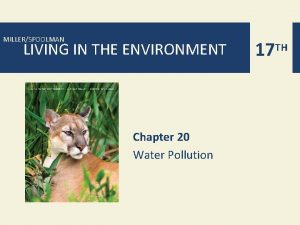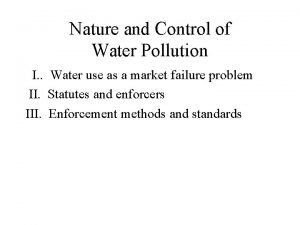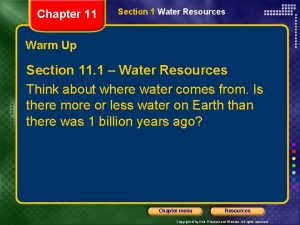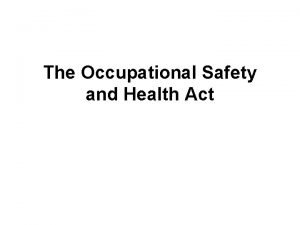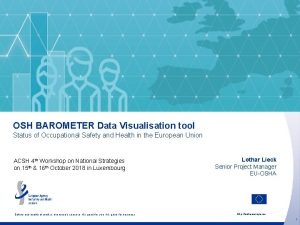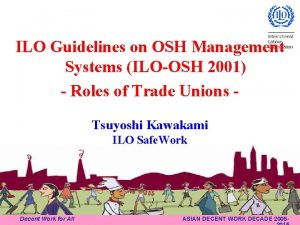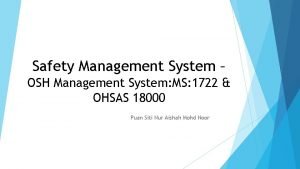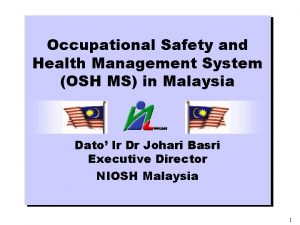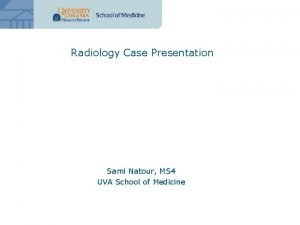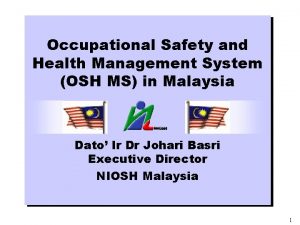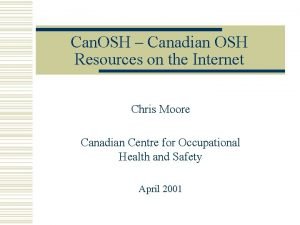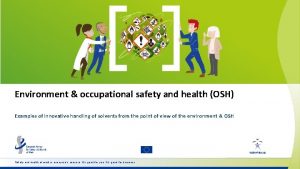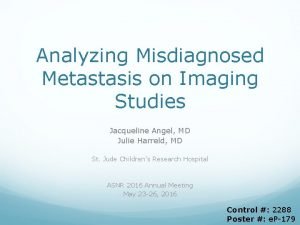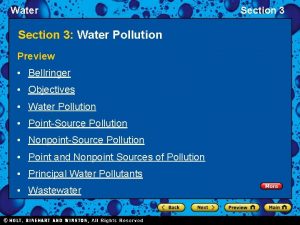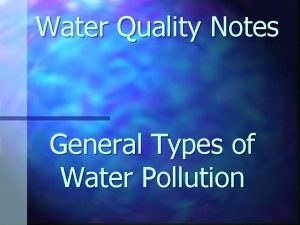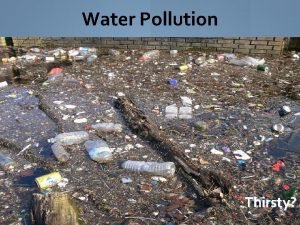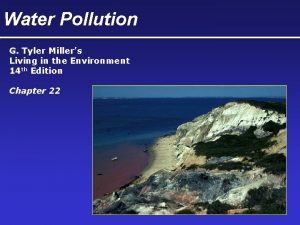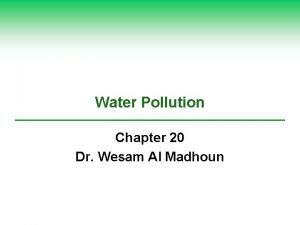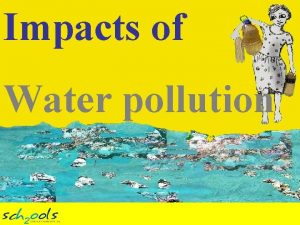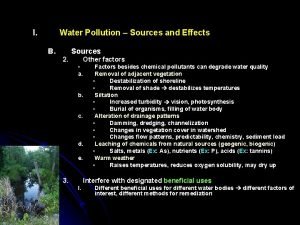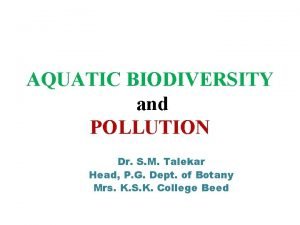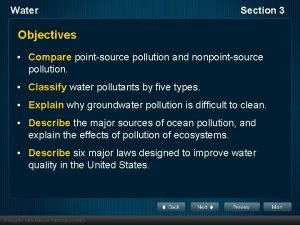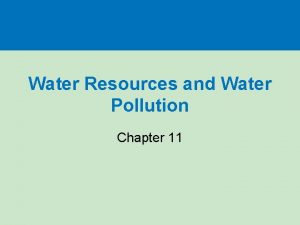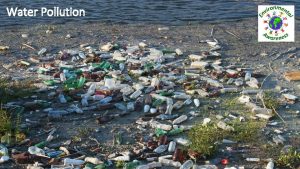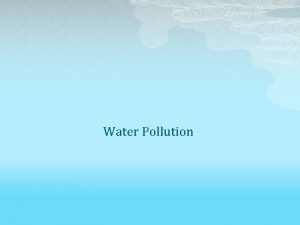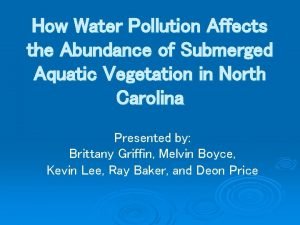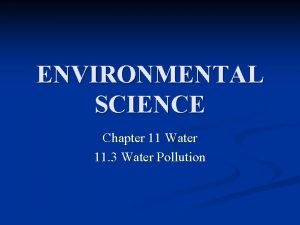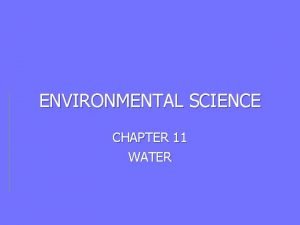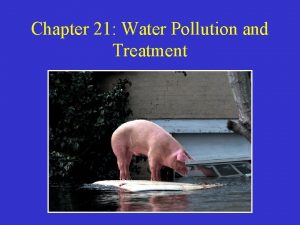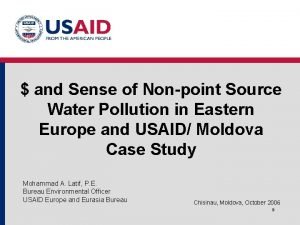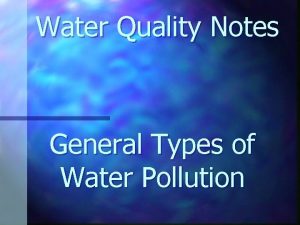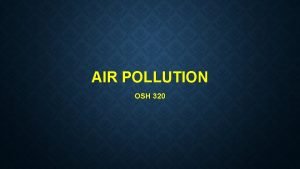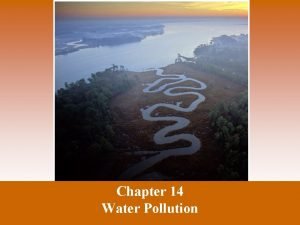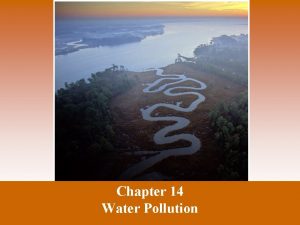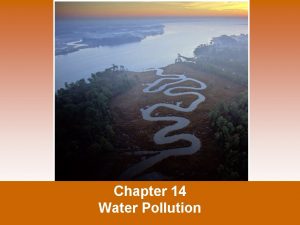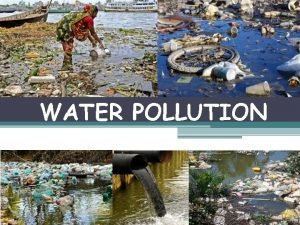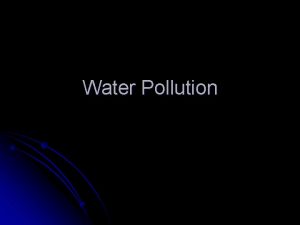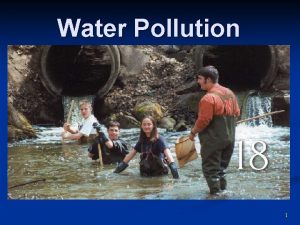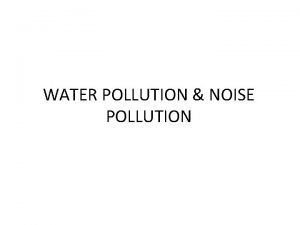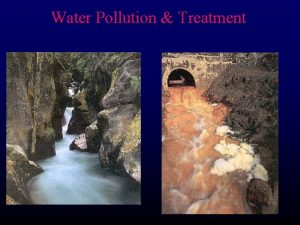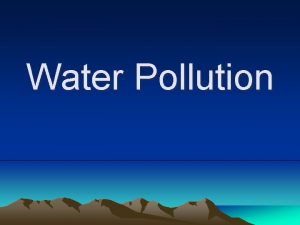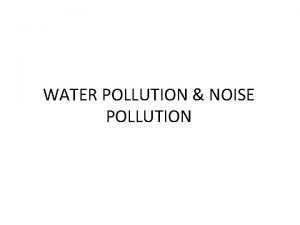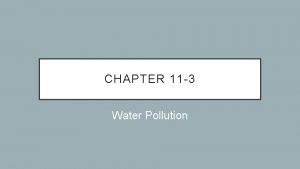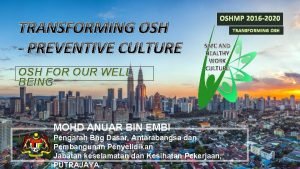CHAPTER 11 LEGISLATING WATER POLLUTION CONTROL OSH 320







































- Slides: 39

CHAPTER 11 LEGISLATING WATER POLLUTION CONTROL OSH 320

FEDERAL WATER POLLUTION CONTROL ACT OF 1972 • Goal was to make all of the nation’s waters fishable and swimmable by 1985. • Established minimal water-quality standards for the nation’s bodies of water and deadlines for industries and cities to reduce their waste discharges. • Classified surface waters according to use • (1) Drinking Water • (2) Swimming and Fishing (most of the nation’s waters fall in this category) • (3) Transportation and Agriculture

AMENDED TO CLEAN WATER ACT - 1977 • 1987 amendments requires all municipalities to have secondary sewage treatment plants in place by July 1, 1988. Supported this effort with $45 billion in federal funding with additional funding from individual states.

INDUSTRIAL SOURCES (POINT SOURCES) • Process wastewater discharges • For purposes of the Clean Water Act, "Process Wastewater" means any water which, during manufacturing or processing, comes into direct contact with or results from the production or use of any raw material, intermediate product, finished product, byproduct, or waste product.

TYPES OF NPDES PERMITS • Individual Permits • Specifically tailored to an individual facility • Based on information in the permit application: • Type of activity • Type of discharge(s) • Receiving water quality • Issued for a specific time period not to exceed 5 years – facility must re-apply before the expiration date.

MAJOR COMPONENTS OF A NPDES PERMIT • Cover Page - Typically contains the name and location of the permittee, a statement authorizing the discharge, and the specific locations for which a discharge is authorized. • Effluent Limits - The primary mechanism for controlling discharges of pollutants to receiving waters. Permit writers spend a majority of their time deriving appropriate effluent limits based on applicable technology-based and water quality-based standards.

MAJOR COMPONENTS OF NPDES PROGRAM • Monitoring and Reporting Requirements - Used to characterize waste streams and receiving waters, evaluate wastewater treatment efficiency, and determine compliance with permit conditions. • Special Conditions - Conditions developed to supplement effluent limit guidelines. Examples include: best management practices (BMPs), additional monitoring activities, ambient stream surveys, and toxicity reduction evaluations (TREs). • Standard Conditions – Pre-established conditions that apply to all NPDES permits and delineate the legal, administrative, and procedural requirements of the permit.

PHASE MS 4 • What is an MS 4? • A conveyance or system of conveyances • Owned by a city, town, or other public entity that discharges to water of the U. S. • Designed to collect or convey stormwater (including drains, pipes, ditches, etc. ) • NOT a combined sewer • NOT part of a POTW (sewage treatment plant)


5 -YEAR STORMWATER MANAGEMENT • Develop an administrative policy or city ordinance prohibiting non-stormwater discharges, including fines and penalties. • Develop an Enforcement Response Plan • Develop and implement procedures for screening, tracking, and identifying sources of illicit discharges

5 -YEAR STORMWATER MANAGEMENT • Train staff on outfall screening protocols • Inspect outfalls quarterly • Maintain stormwater system features

CONSTRUCTION SITE RUNOFF CONTROL • Require contractors to implement Stormwater Pollution Prevention Plans (SWPPP) and obtain a Notice of Coverage (NOC) • Develop a SWPPP review process • Conduct monthly site audits on construction projects disturbing one acre or more to determine compliance.

CONSTRUCTION SITE RUNOFF CONTROL • Develop enforcement procedures for SWPPP violations. • Develop a method for the public to provide comments and complaints regarding construction activity.

PERMANENT STORMWATER MANAGEMENT • Develop and implement a set of requirements to establish, protect, and maintain a permanent water quality buffer along all waters of the state. • Require permanent stormwater management practices on projects that disturb 1 acre or more.

PERMANENT STORMWATER MANAGEMENT • Conduct inspections to ensure controls are being installed correctly. • Develop BMP (Best Management Practices) operation and maintenance plans. • Train staff performing inspections on permanent BMPs.

POLLUTION PREVENTION AND GOOD HOUSEKEEPING • Update procedures related to trash pickup, irrigation practices, chemical storage, outdoor materials storage • Update ordinances in regards to vehicle maintenance activities • Develop procedures related to street sweeping, parking lot cleaning activities

CONSTRUCTION GENERAL PERMIT – STORMWATER PERMIT • Submit NOI – Notice of Intent • Requirements for: • Erosion and Sediment Controls • Soil Stabilization • Dewatering • Pollution prevention measures • Prohibited Discharges • Surface Outlets

CONSTRUCTION GENERAL PERMIT – STORMWATER PERMIT • Stormwater Pollution Prevention Plan (SWPPP) – Key Component for compliance. • Contact Information / Responsible Parties • Site Evaluation / Assessment • Documentation of compliance with Endangered Species Act, Historic Preservation, and Safe Drinking Water (Underground injection) • Erosion and Sediment Controls (Bulk of plan)

CONSTRUCTION GENERAL PERMIT – STORMWATER PERMIT • Pollution prevention standards • Inspection and Corrective Action • Training • Certification and Notification • Appendices

SPILL PREVENTION, CONTROL AND COUNTERMEASURE (SPCC)

BACKGROUND INFORMATION • The Clean Water Act established a comprehensive program “to restore and maintain the chemical, physical, and biological integrity of the Nation’s waters. ” US EPA's Oil Pollution Prevention Regulation was published in the Federal Register on December 11, 1973.

BACKGROUND INFORMATION • The Oil Pollution Prevention regulation, promulgated under the authority of § 311 of the Clean Water Act (CWA), sets forth requirements for… • Prevention of Spills • Preparedness for Spills • Response to oil discharges • Prevent oil discharges from reaching navigable waters and adjoining shorelines • Contain discharges of oil • Develop and implement SPCC Plans • Establish procedures, methods, and equipment requirements

WHO IS REGULATED BY THE SPCC REGULATIONS? • Non-transportation-related; (Industrial, commercial, agricultural, or public facilities that use, store, drill for, produce, gather, process, refine or consume oil or oil products; Certain waste treatment facilities; ) • It must have an aggregate aboveground storage capacity greater than 1, 320 gallons or a completely buried storage capacity greater than 42, 000 gallons; and • There must be a reasonable expectation of a discharge into or upon navigable waters of the United States or adjoining shorelines.

WHAT IS CONSIDERED AS OIL STORAGE CAPACITY? • 55 gallons containers or above. • Oil storage containers include, but are not limited to, • Tanks • Containers • Drums • Transformers • Oil-filled electrical equipment (e. g. , hydraulic systems, lubricating systems, machining cooling systems, circuit breakers) • Mobile or portable totes.

WHAT IS AN OIL? • Under the SPCC regulations, oil is defined as “Oil of any kind or in any form including, but not limited to: • Petroleum • Fuel Oil • Sludge • Oil Refuse • Oil mixed with wastes other than dredged spoil and oily mixtures • Non-petroleum Oils • Synthetic Oils • Animal Fats • Oils and Greases • Vegetable Oils

WHAT IS NOT AN OIL? • Antifreeze • Windshield Wiper Fluid • Soaps • Waste Water (as long as does not contain oil products) • Porta-potty fluids • Cleaning Solutions • Landfill Leachate • Acids • Bases • Various Chemicals (Chlorine, certain pesticides, herbicides, industrial chemicals, etc. )

HOW DO I DETERMINE IF MY FACILITY COULD REASONABLY DISCHARGE OIL INTO OR UPON NAVIGABLE WATERS OR ADJOINING SHORELINES? • Determination based on geographical and locational aspects of the facility • Nearby Streams, ponds, ditches • Storm or Sanitary Sewers • Dry Wells • Distance to Navigable Waters • Drainage patterns • Soil Conditions • Volume of material stored • Cannot include consideration of man-made features such as dikes, equipment or other structures (like levees) that may serve to restrain, hinder, contain or prevent an oil discharge.

ASPECTS OF A SPCC PLAN • Certified by the site management and the Professional Engineer or • Self certify if: Total aboveground oil storage capacity of 10, 000 U. S. gallons or less, and in last 3 years no single discharge of oil to navigable waters or adjoining shorelines exceeding 1, 000 U. S. gallons, or no two discharges of oil to navigable waters or adjoining shorelines each exceeding 42 U. S. gallons within any 12 -month period

ASPECTS OF A SPCC PLAN • Facility Information • Site History • Spills • Oil Products • Fueling Operations • Site Security

FACILITY SITE PLAN • General site layout • Location of Storage Tanks (Aboveground and Underground) • Tank Capacities • Tank Contents • Location of Piping (Aboveground and Underground) • Location of Tank Dispensers • Site flow directions and drainage features

FACILITY SITE PLAN CONT. • Location of any containment structures • Location of Floor Drains • Equipment parking locations and layout (include if paved or not) • Material storage areas and layout • Location of spill control and countermeasure equipment (floor dry, etc. ) • Locations of Potential outfalls

FACILITY DRAINAGE AND STORM WATER MANAGEMENT • Surface Drainage features and how Storm Water is managed. • Retention Basins • Swales, Ditches, Washes

PERSONNEL TRAINING • Spill Prevention Training • Prevent discharge of oil or hazardous substances • Spill response training • Vehicle loading/unloading procedures

EMERGENCY PROCEDURES/SPILL RESPONSE • Emergency procedures for dealing with a release of oil products. • Extinguishing of ignition sources • Stopping of release at the source • Containment of the release • Spill cleanup • Reporting

EMERGENCY CONTACTS AND REPORTING • Internal contacts • Spill reporting thresholds • Reporting to outside agencies

FACILITY INSPECTIONS/OBSERVATIONS • Site Inspections • Daily Observations • Integrity Testing

SPCC INSPECTIONS • Oil Storage Tanks • Fueling Operations • Site Security • Seals and Gaskets • Pipes and Valves • Overfill Protection Devices • Container Supports and Foundations • Secondary Containment • Equivalent Environmental Protection • Surface Drainage

EQUIVALENT ENVIRONMENTAL PROTECTION • Description of equivalent environmental protection practices employed at the site. • Integrity testing • Overfill protection • Lighting requirements • Site Security

APPENDICES • Spill Response Procedures and Contacts • SPCC Regulations – 40 CFR § 112. • State Regulations • Personnel Training Records • Inspection Records • Incident Report Forms
 Water and water and water water
Water and water and water water Methods of water pollution
Methods of water pollution Source of thermal pollution
Source of thermal pollution Control measures of water pollution ppt
Control measures of water pollution ppt Chapter 11 section 3 water pollution
Chapter 11 section 3 water pollution Chapter 11 section 2 water use and management
Chapter 11 section 2 water use and management Occupational safety and health objectives
Occupational safety and health objectives Osh barometer
Osh barometer Ilo osh 2001
Ilo osh 2001 Component of osh-ms 1722
Component of osh-ms 1722 Osh ms
Osh ms Uva radiology tutorial
Uva radiology tutorial Osh ms
Osh ms Osh canada
Osh canada Osh state medical university logo
Osh state medical university logo Osh examples
Osh examples Osh mri
Osh mri Sources of groundwater pollution
Sources of groundwater pollution Explain water pollution
Explain water pollution Water pollution through the years
Water pollution through the years Three source of water
Three source of water What are the terrible twelve water pollution
What are the terrible twelve water pollution Solutions to water pollution
Solutions to water pollution Soil pollution effects on human health
Soil pollution effects on human health 8 effects of water pollution
8 effects of water pollution Land water and air pollution
Land water and air pollution Effects of water pollution
Effects of water pollution Ddt water pollution
Ddt water pollution What are 5 effects of water pollution?
What are 5 effects of water pollution? Aims and objectives of water pollution
Aims and objectives of water pollution How we can reduce water pollution
How we can reduce water pollution Conclusion of water pollution
Conclusion of water pollution Types of water pollution
Types of water pollution Water pollution and unequal distribution illustration
Water pollution and unequal distribution illustration Summary of water pollution
Summary of water pollution Introduction water pollution
Introduction water pollution Chapter 11 water environmental science
Chapter 11 water environmental science Introduction of water pollution
Introduction of water pollution Observation of water contamination
Observation of water contamination Nasa space shuttle
Nasa space shuttle

